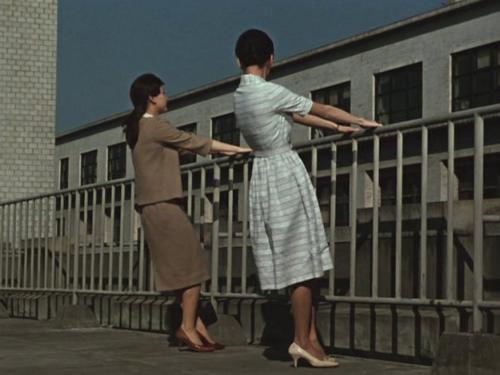
A widow tries to marry off her daughter with the help of her late husband's three friends.
“As the title suggests, Late Autumn is tinged with a sense of the inevitable end of things – especially happiness. In a variant of Ozu’s favorite theme, a widow lives quietly with her devoted daughter, who rebuffs any suggestion that she should be married. Three middle-aged businessmen, old friends of the family, try to act as matchmakers and decide that the widow must be married first, to ‘free’ the daughter of her familial obligations. Ozu said of Late Autumn: ‘People sometimes complicate the simplest things. Life, which seems complex, suddenly reveals itself as very simple – and I wanted to show that in this film.’ He makes of this situation both a comedy – as the well-intentioned schemes of the three businessmen go awry – and an elegy of transience.”
Harvard Film Archive1
“In this beautiful, touching, bittersweet comedy, a mature masterpiece made three years before his death in 1963, Ozu brought his delicate minimalist technique to bear on the story of three middle-aged businessmen matchmaking for the widow and daughter of their closest friend. In different ways – visual texture, sharp social criticism underlying an apparently bland surface, the tensions of quiet lives – I was reminded of affinities between Ozu’s films and those of Douglas Sirk and Eric Rohmer.”
Philip French2
“Ozu has spend his entire carreer examining and revealing people’s reactions, is also the best one at it. The only director who comes close to Ozu in presenting people as they truly are us Chaplin. One aspect of Chaplin’s realism is his so-called ‘vulgarity’, something which some critics considered in bad taste. This aspect of realism also appears in Ozu’s films, but the East, unlike the West, does not frown upon it.”
Marvin Zeman3
“Late Autumn continues Ozu’s own exploration of Japan’s past through the interaction of old and young, male and female. Like Early Spring, Equinox Flower, and Floating Weeds, it bears some trace of the ‘youth cult’ films of the late 1950s; it aslo continues to mock male vanity and juxtapose the bland comfort of the postwar era with memories of what went before.”
David Bordwell4
“Again, you sense that Ozu was studying a generation in transition—those who were often torn between traditions and the powerful instinct that it was time to overturn them. And the older generation's efforts to sculpture the young only clench the latter's resistance to the models offered to them.”
Nora Sayre5
“The complexity of tone is also carried by the style’s unusually sharp juxtaposition of rigor and playfulness. Late Autumn is one of the most outrageously sporting of Ozu’s postwar works, in the same class as Good Morning and An Autumn Afternoon. Here he relies on our knowledge of his earlier films in order to undermine our predictions about stylistic patterning.”
David Bordwell6
- 1Harvard Film Archive.
- 2Philip French, “Late Autumn,” The Guardian, 31 January 2010.
- 3Marvin Zeman, “The Serene Poet of Japanese Cinema: The Zen Artistry of Yasujiro Ozu,” The Film Journal vol. 1, 1972, nr. 3-4 (1972).
- 4David Bordwell, Ozu and the Poetics of Cinema (Princeton: Princeton University Press, 1994), 360-361.
- 5Nora Sayre, “Ozu’s Late Autumn Like a Day in the Sun: The Cast,” The New York Times, 17 October 1973.
- 6David Bordwell, Ozu and the Poetics of Cinema (Princeton: Princeton University Press, 1994), 363.

